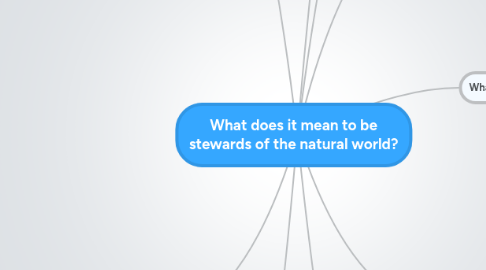
1. What is Alberta' Geography?
1.1. Vegetation
1.2. Natural Resources
1.3. Hydrology
1.3.1. What are Alberta's Natural Regions?
1.3.2. How does Alberta's Geography affect lifestyle?
1.4. Climate
1.5. Animal life
2. How do Albertan's deal with competing demands on land use between Recreation, Resource Development and Environmental Protection?
2.1. What are Alberta's Natural Resources? Where are they found?
2.1.1. Agriculture
2.1.2. Forestry
2.1.3. Energy Resources
2.1.4. What are the possibilities and challenges of developing Alberta's Natural Resources?
2.1.4.1. What are renewable and non-renewable resources?
2.1.5. Water
2.2. What recreational activities do we enjoy in nature?
2.2.1. Tourism
2.2.2. Hunting/Fishing
2.2.2.1. What are the positive and negative impacts of recreational activities?
2.2.2.1.1. What can we do to reduce our impact?
2.2.3. Hiking
2.2.4. Bird and animal watching
2.3. Environmental Protection
2.3.1. Who makes laws and regulations?
2.3.2. Who is responsible for enforcement?
2.3.2.1. How can citizens get involved?
2.3.2.1.1. What can we do individually and collectively to protect the natural world?
2.3.2.1.2. How can we share what we have learned with others?
2.3.3. What role does education play in protecting the environment?
2.3.3.1. What are some groups that educate the public that we can access?
2.3.3.1.1. National & Provincial Park Education Programs
2.3.3.1.2. CPAWS
2.3.3.1.3. Sierra Club
2.3.3.1.4. City of Calgary
2.3.3.1.5. Virtual Researchers in the Classroom
2.3.3.1.6. Twitter and Blog Connections
2.3.3.1.7. U of C Solar Car Team
2.3.3.1.8. Inside Education
2.3.3.1.9. Calgary Zoo
2.3.3.1.10. Inglewood Bird Sanctuary
3. What is Albertan's relationship to the land in the past, present and future?
3.1. First Nations
3.1.1. What do stories of First Nation's tell us about their beliefs about the land?
3.1.2. How did land shape ways of life?
3.2. First Settlers
3.2.1. Why did different groups of people come to Alberta?
3.3. Fur Trade
3.3.1. What was the environmental impact of the Fur trade?
3.4. Uraban vs Rural
4. What is an Ecological Footprint?
4.1. Water
4.2. Waste
4.3. Transportation
4.3.1. What can we do individually and collectively to reduce our Ecological Footprint?
4.4. Energy
4.5. Food
5. Why is Cross Conservation Area Important?
5.1. To plants animals and insects
5.1.1. What plants and animals live in this area?
5.1.1.1. What is biodiversity?
5.1.1.2. What are plant, animal and insect lifescycles?
5.1.1.3. Adapatations
5.1.1.4. What are the different habitats?
5.1.2. How is this area affected by human actions?
5.1.2.1. How can we care for this area?
5.1.2.1.1. What are the rules while at Cross Conservation?
5.1.2.2. What does Species At Risk mean?
5.1.3. How does this area change over time?
5.1.4. How does this area change with the seasons?
5.2. To people
5.2.1. Why was the Cross Conservation Area Created?
5.2.1.1. Stewardship
5.2.1.2. Conservation
5.2.1.3. How can citizen's and government work together?
6. What is Stewardship?
6.1. What are the Biblical roots of Stewardship?
6.2. We are called to justice and peace!
6.2.1. What is conservation?
6.2.2. What is sustainable?
6.2.3. What is protection?
6.3. What is environmental justice?
7. Possible Activities at Cross Conservation
7.1. Journaling
7.1.1. Ten/Ten
7.1.2. Sound Mapping
7.1.3. Plant Rubbings
7.1.4. Mapping
7.1.5. Every Object Has a Story
7.1.6. Poetry
7.1.6.1. Imagine a Place
7.1.6.2. Dear World
7.1.6.3. I Am A...
7.1.7. Water Colour Art
7.1.8. I saw, I felt, I thought, I wondered...
7.2. Photography
7.3. Make a video about your favourite area
7.4. Create a plant, animal and track ID book
7.5. Guest Speakers
7.6. Looking at Biofacts
8. Preparation for Cross Conservation
8.1. How to dress
8.2. Make Sit Upons
8.3. Using the Journals in all weather
8.4. Using cameras
8.5. Journaling techniques
8.6. Wonderings..
8.7. Preparation meeting for parents
8.8. Understanding behaviour expectations
9. Follow up activities for after Cross Conservation
9.1. Publish Imagine Poems and Art
9.2. Make memory collage using pictures from our week
9.3. Students will blog about their experiences
9.3.1. Poetry
9.3.2. Sketches
9.3.3. Writing/observations
9.3.4. My favourite area
9.3.5. Photography
9.4. Student initiated eco-actions
9.4.1. Linked with Destination Conservation
